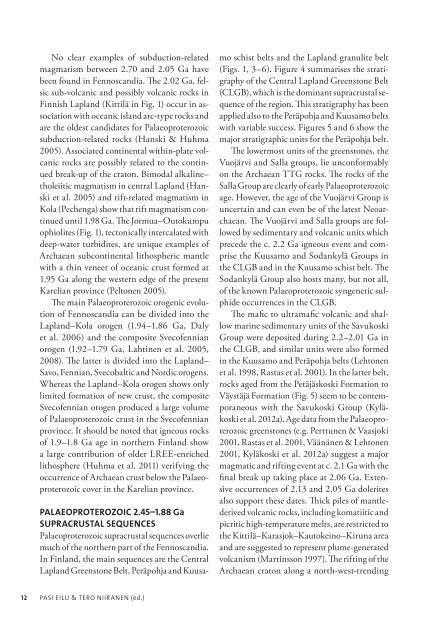Gold deposits in northern Finland - Arkisto.gsf.fi
Gold deposits in northern Finland - Arkisto.gsf.fi
Gold deposits in northern Finland - Arkisto.gsf.fi
Create successful ePaper yourself
Turn your PDF publications into a flip-book with our unique Google optimized e-Paper software.
No clear examples of subduction-related<br />
magmatism between 2.70 and 2.05 Ga have<br />
been found <strong>in</strong> Fennoscandia. The 2.02 Ga, felsic<br />
sub-volcanic and possibly volcanic rocks <strong>in</strong><br />
F<strong>in</strong>nish Lapland (Kittilä <strong>in</strong> Fig. 1) occur <strong>in</strong> association<br />
with oceanic island arc-type rocks and<br />
are the oldest candidates for Palaeoproterozoic<br />
subduction-related rocks (Hanski & Huhma<br />
2005). Associated cont<strong>in</strong>ental with<strong>in</strong>-plate volcanic<br />
rocks are possibly related to the cont<strong>in</strong>ued<br />
break-up of the craton. Bimodal alkal<strong>in</strong>e–<br />
tholeiitic magmatism <strong>in</strong> central Lapland (Hanski<br />
et al. 2005) and rift-related magmatism <strong>in</strong><br />
Kola (Pechenga) show that rift magmatism cont<strong>in</strong>ued<br />
until 1.98 Ga. The Jormua–Outokumpu<br />
ophiolites (Fig. 1), tectonically <strong>in</strong>tercalated with<br />
deep-water turbidites, are unique examples of<br />
Archaean subcont<strong>in</strong>ental lithospheric mantle<br />
with a th<strong>in</strong> veneer of oceanic crust formed at<br />
1.95 Ga along the western edge of the present<br />
Karelian prov<strong>in</strong>ce (Peltonen 2005).<br />
The ma<strong>in</strong> Palaeoproterozoic orogenic evolution<br />
of Fennoscandia can be divided <strong>in</strong>to the<br />
Lapland–Kola orogen (1.94–1.86 Ga, Daly<br />
et al. 2006) and the composite Svecofennian<br />
orogen (1.92–1.79 Ga, Laht<strong>in</strong>en et al. 2005,<br />
2008). The latter is divided <strong>in</strong>to the Lapland–<br />
Savo, Fennian, Svecobaltic and Nordic orogens.<br />
Whereas the Lapland–Kola orogen shows only<br />
limited formation of new crust, the composite<br />
Sveco fennian orogen produced a large volume<br />
of Palaeoproterozoic crust <strong>in</strong> the Svecofennian<br />
prov<strong>in</strong>ce. It should be noted that igneous rocks<br />
of 1.9–1.8 Ga age <strong>in</strong> <strong>northern</strong> F<strong>in</strong>land show<br />
a large contribution of older LREE-enriched<br />
litho sphere (Huhma et al. 2011) verify<strong>in</strong>g the<br />
occurrence of Archaean crust below the Palaeoproterozoic<br />
cover <strong>in</strong> the Karelian prov<strong>in</strong>ce.<br />
Palaeoproterozoic 2.45–1.88 Ga<br />
supracrustal sequences<br />
Palaeoproterozoic supracrustal sequences overlie<br />
much of the <strong>northern</strong> part of the Fennoscandia.<br />
In F<strong>in</strong>land, the ma<strong>in</strong> sequences are the Central<br />
Lapland Greenstone Belt, Peräpohja and Kuusamo<br />
schist belts and the Lapland granulite belt<br />
(Figs. 1, 3–6). Figure 4 summarises the stratigraphy<br />
of the Central Lapland Greenstone Belt<br />
(CLGB), which is the dom<strong>in</strong>ant supracrustal sequence<br />
of the region. This stratigraphy has been<br />
applied also to the Peräpohja and Kuusamo belts<br />
with variable success. Figures 5 and 6 show the<br />
major stratigraphic units for the Peräpohja belt.<br />
The lowermost units of the greenstones, the<br />
Vuojärvi and Salla groups, lie unconformably<br />
on the Archaean TTG rocks. The rocks of the<br />
Salla Group are clearly of early Palaeoproterozoic<br />
age. However, the age of the Vuojärvi Group is<br />
uncerta<strong>in</strong> and can even be of the latest Neoarchaean.<br />
The Vuojärvi and Salla groups are followed<br />
by sedimentary and volcanic units which<br />
precede the c. 2.2 Ga igneous event and comprise<br />
the Kuusamo and Sodankylä Groups <strong>in</strong><br />
the CLGB and <strong>in</strong> the Kuusamo schist belt. The<br />
Sodan kylä Group also hosts many, but not all,<br />
of the known Palaeoproterozoic syngenetic sulphide<br />
occurrences <strong>in</strong> the CLGB.<br />
The ma<strong>fi</strong>c to ultra ma<strong>fi</strong>c volcanic and shallow<br />
mar<strong>in</strong>e sedimentary units of the Savukoski<br />
Group were deposited dur<strong>in</strong>g 2.2–2.01 Ga <strong>in</strong><br />
the CLGB, and similar units were also formed<br />
<strong>in</strong> the Kuusamo and Peräpohja belts (Lehtonen<br />
et al. 1998, Rastas et al. 2001). In the latter belt,<br />
rocks aged from the Petäjäskoski Formation to<br />
Väystäjä Formation (Fig. 5) seem to be contemporaneous<br />
with the Savukoski Group (Kyläkoski<br />
et al. 2012a). Age data from the Palaeoproterozoic<br />
greenstones (e.g. Perttunen & Vaasjoki<br />
2001, Rastas et al. 2001, Väänänen & Lehtonen<br />
2001, Kyläkoski et al. 2012a) suggest a major<br />
magmatic and rift<strong>in</strong>g event at c. 2.1 Ga with the<br />
f<strong>in</strong>al break up tak<strong>in</strong>g place at 2.06 Ga. Extensive<br />
occurrences of 2.13 and 2.05 Ga dolerites<br />
also support these dates. Thick piles of mantlederived<br />
volcanic rocks, <strong>in</strong>clud<strong>in</strong>g komatiitic and<br />
picritic high-temperature melts, are restricted to<br />
the Kittilä–Karasjok–Kauto ke<strong>in</strong>o–Kiruna area<br />
and are suggested to represent plume-generated<br />
volcanism (Mart<strong>in</strong>sson 1997). The rift<strong>in</strong>g of the<br />
Archaean craton along a north-west-trend<strong>in</strong>g<br />
12 Pasi Eilu & Tero Niiranen (ed.)
















